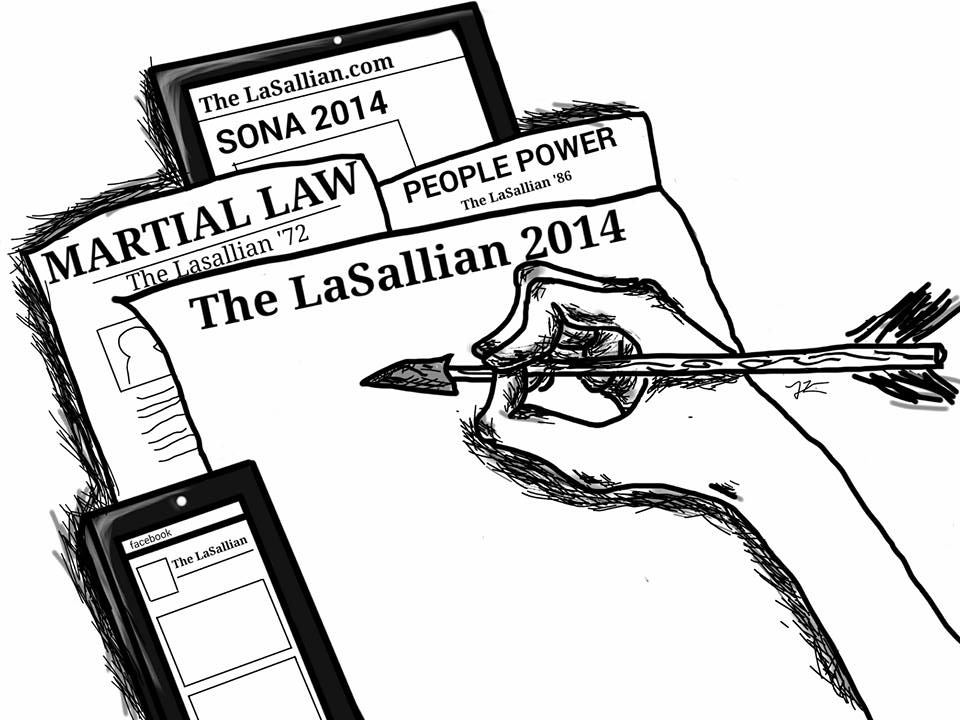The inaugural issue of The LaSallian was published on October 24, 1960, back when De La Salle University (DLSU) was still De La Salle College (DLSC), a full 15 years before being granted University status. In those days, the iconic St. Joseph Hall was barely four years old and the Taft Avenue campus still housed a high school that was eight years away from dissolution. At that time, even the barest idea of today’s familiar and modern campus fixtures, the 21-storey Br. Andrew Gonzalez Hall and the Henry Sy Sr. Hall, were nonexistent.
Back then, La Salle’s athletes competed in the NCAA, not the UAAP, and the LRT, which now stands prominently along Taft Avenue, was 34 years away from its first day of operations. From a national perspective, it was 12 years before Filipinos would get a taste of the tyranny and dictatorship of Martial Law.
In that same year, President Carlos P. Garcia dedicated a portion of his State of the Nation Address to discuss the country’s graft and corruption problems. The anti-graft campaign of the sixties investigated over 12,000 cases of corruption and found over 4,000 officials guilty. “In spite of this creditable record of achievements,” Garcia maintained, “There still remains a tremendous amount of work to be done.”
Garcia probably did not know how right he was. Since then, the country’s corruption problem grew from bad to worse. The Philippines had seen seven presidents after Garcia, two of whom were thrown out of office after the 1986 and 2001 People Power Revolutions, respectively. One of these two “served” as president for 21 years while various accusations of graft and corruption have been hurled at others, particularly the more recent ones.
Today, the Philippines remains the ‘Sick Man of Asia,’ despite all of President Benigno Aquino III’s claims to the contrary. Though the Philippines’ recent increase in investment grade status and continued rise in economic and financial rankings is impressive and a positive indicator of growth, it is public knowledge that the country remains riddled with corruption, a social cancer that will hold back any long term progress. Economic growth remains a concept, not a reality felt by those who most desperately need it.
It has been 54 years since Garcia’s statement, yet the headlines today are still filled with stories of corruption, most notably regarding the ongoing investigations on former Makati City Mayor and current Philippine Vice President Jejomar Binay. His is a case that involves the overpricing of government projects, undeclared assets, and under the table transactions, and it grows even larger by the day as more details are discovered and new alleged accomplices are revealed.
If there is anything that has remained constant in the past half-century, it is that the problem of corruption goes beyond one official and his cronies. Given proper time and investigation, the country could fill an entire hall of infamy, housing thousands of names and unimaginable amounts of taxpayers’ stolen money, which could have otherwise been allocated to programs that provide for the most basic needs of the poorest Filipinos. Philippine history continues to repeat itself, following the same script though employing different actors every few years. The names may change and certain details may vary, but the core issues remain the same.
Fifty-four years is too long a time to suffer at the hands of corrupt officials, and the years make the problem seem like a constant even if we have the power to make things different. DLSU is not a thing set apart from society, and Lasallians are, now more than ever, in the position to be catalysts of change, not just within the University, but in the context of the social, political, and economic life of the country. This may be a cliché hammered into our heads from years of privileged education, but it is nonetheless truthful and crucial today. Earlier generations have come and gone, and now it is our turn.
Just as it was 54 years ago, when DLSC students first put pen to paper and created this publication, the battle against corruption is of utmost importance. The pioneering editors had promised that The LaSallian “Will continue to serve the ideals of the students and the school it symbolizes,” and this is something that we strive to do to this day by delivering the truth and inspiring critical thinking.
We cannot just wait for things to change, but rather, we must examine how the wait is changing us. We must strive to do what we can to achieve genuine change on this day, and the next, until one, 10, or even 50 years have gone by. Fifty-four years after our first issue came to print, President Garcia’s words still ring true: There is still a tremendous amount of work to be done. And we must do it.

4 replies on “To this day”
.
ñïàñèáî çà èíôó!!
.
áëàãîäàðþ.
.
good.
.
ñïñ çà èíôó!